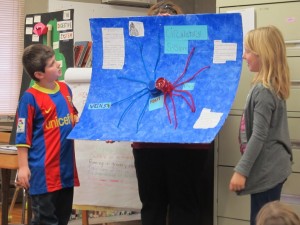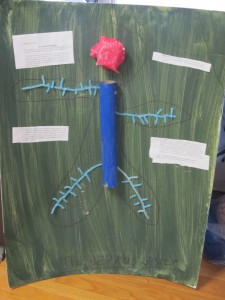The older students began their exploration of the human body by learning about the skeletal system. They took part in a variety of activities that helped them come to conclusions about the human body. Insightful discussion took place about what bones we have in our bodies and where they are located after jumping rope and thinking about how our body is able to move. By feeling their own arms, legs, head, and torso they each came up with an estimation of how many bones we have and then compared their numbers to a more accurate count they found by looking at posters of the skeletal system. Students were surprised how difficult it was to put together a skeletal puzzle of “Mr. Bones,” but they persevered and were then able to discuss how bones are connected by joints, tendons, and ligaments. Another activity they had fun with was learning about the benefits of having opposable thumbs. They experienced this by taping their thumbs to their index fingers and then figuring out how to write their name, tie their shoes and button a button.
The older students concluded their exploration of the human body by researching the circulatory, respiratory, nervous and muscular systems. Each set of partners was assigned a specific system. They used books and internet resources to educate themselves about the parts, purposes, problems and preventions of their system. Each group used their writing skills to type a paragraph describing each category. They used what they learned to create very inventive 3D posters representing their system that they presented to all the students.

